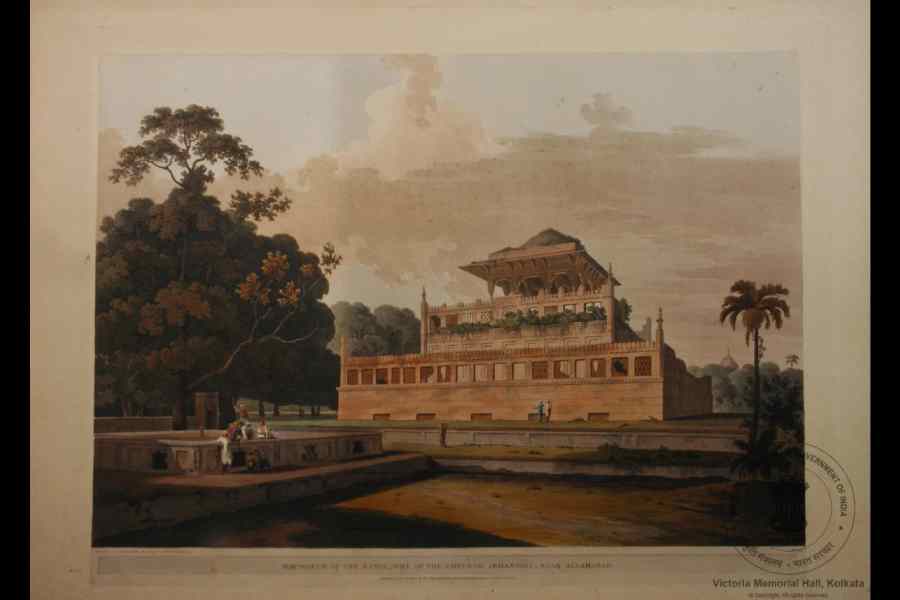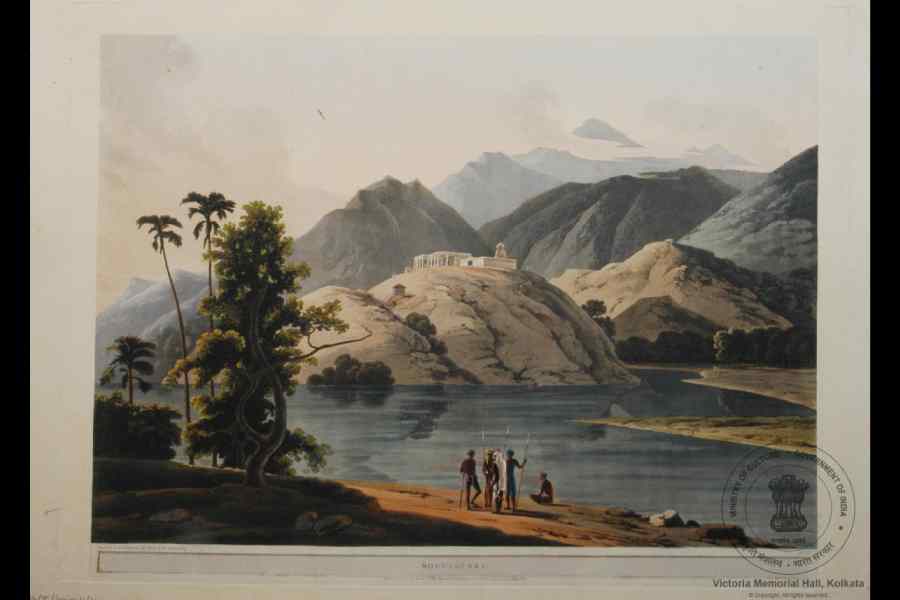The splendid aquatint by Thomas and William Daniell titled Shevagurry, a place which is located on the Mysore plateau, is part of the book, Oriental Scenery: Twenty-four Views in Hindoostan. It is displayed at an exhibition of selected engravings by the Daniells depicting exotic landscapes and ruins at magnificent archaeological sites meant for the consumption of the people of the West and, definitely, for the British rulers unfamiliar with such wildernesses and monumental debris. The exhibition, India: In the Eyes of Thomas and William Daniell, is being held in the Durbar Hall of the Victoria Memorial Hall, which possesses the largest collection of oil paintings by the uncle-nephew duo.
The engraving depicts a mighty river flowing through a range of hills (cloud-capped for added effect) and inselbergs, on the flat top of one of which is what looks like a Hindu temple with a gopuram and a much smaller construction near it. In the foreground is a clump of trees that possibly defy classification. Two of these trees resembling stilts and topped with fronds are probably palms. On the river bank is a group of half-naked Indians, about four of them standing, while the fifth sits on the ground. All of them wear turbans and loincloths and carry spears except one man who has his head and back covered with a white cloth.

Mausoleum of the Ranee, Wife of the Emperor Jehangire, Near Allahabad by Thomas and William Daniell [Source: Victoria Memorial Hall]
Thomas Daniell (1749-1840) was born in an English family of painters and printmakers in London. Trained at the Royal Academy, he decided to try his fortune in India as a professional artist. His nephew, William (1769-1837), at age 15, sailed for India with his uncle and reached Calcutta in 1786. During their seven-year sojourn in India, they reached the furthest reaches of the subcontinent, regions no Western artist had ever visited before. They recorded the landscape, the architecture and the peoples of this land with accuracy and sensitivity and, by publishing their engravings on returning home, they opened the eyes of the West to this ancient, unregenerate land. The six volumes of Oriental Scenery were published in 1808.
In the 18th century, Englishmen through nurture — the application of science — tried to “tame” India’s wild nature by establishing Howrah’s botanical garden. In the same way, artists from the West in their pursuit of the picturesque that was so fashionable then and in the century that followed, attempted to demystify this antique land by drawing and painting its wondrous sights.
There is the rope bridge in Srinagar, Kashmir, the ithyphallic Qutub Minar amidst deserted surroundings, the grand “pagodas” of the South, Jantar Mantar with its curious forms, the temples of Vrindavan and the piles of Gaur on the verge of being swallowed up by parasitic vegetation. The Elephanta Caves with their colossal carvings and the Kailasha temple of Ellora are quite as awesome as the majestic Mughal architecture.
Equally impressive are the vistas of distant hills and a waterbody at Ramgarh, the Bo tree in Gaya with its devotee prostrating himself before it, and the pounding sea before Chennai’s Fort St. George. Humans are dwarfed by these outstanding presences, though in their eye-catching gear they stand out despite being faceless. It is only in the view of Chowringhee that we see a modern city, the street lined with palaces. It was in this city of Calcutta constructed by the British that we realise the blessings of colonisation.











